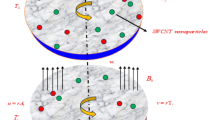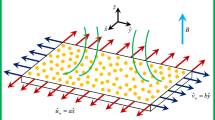Abstract
A simple mathematical model depicting blood flow in the capillary is developed with an emphasis on the permeability property of the blood vessel based on Starling's hypothesis. In this study the effect of inertia has been neglected in comparison with the viscosity on the basis of the smallness of the Reynolds number of the flow in the capillary. The capillary blood vessel is approximated by a circular cylindrical tube with a permeable wall. The blood is represented by a couple stress fluid. With such an ideal model the velocity and pressure fields are determined. It is shown that an increase in the couple stress parameter increases the resistance to the flow and thereby decreases the volume rate flow. A comparison of the results with those of the Newtonian case has also been made.
Similar content being viewed by others
Literature
Bugliarello, G., C. Kapur and G. Hsiao. 1965. “The Profile Viscosity and other Characteristics of Blood Flow in a Non-uniform Shear Field”. Symposium on Biorheology, Proc. 4th Int. Cong. Rheology, New York: Interscience.
— and J. Sevilla. 1970. “Velocity Distribution and other Characteristics of Steady and Pulsatile Blood Flow in Fine Glass Tubes”.Biorheology 7, 85–107.
Cokelet, G. R. 1972.Biomechanics: Its Foundations and Objectives, Y. G. Fung (Ed.), p. 63. Englewood Cliffs: Prentice Hall.
Goldsmith, H. L. and R. Skalak. 1975.Annual Review of Fluid Dynamics, p. 231. California: Annual Review Inc. Palo Alto.
Lighthill, M. J. 1969. “Motion in Narrow Capillaries from the Stand Point of Lubrication Theory”. InCirculatory and Respiratory Mass Transport, G. E. N. Wolstenholme and J. Knight (Eds.), pp. 85–96. London: Churchill.
Oka, S. and T. Murata. 1970. “A Theoretical Study of the Flow of Blood in a Capillary with Permeable Wall”.Jap. J. Appl. Phys. 9, 345–352.
— 1981.Cardiovascular Hemotheology, p. 90. Cambridge: Cambridge University Press.
Popel, A. S., S. A. Regirer and P. I. Usick. 1974. “A Continuum Model of Blood Flow”.Biorheology 11, 427–437.
Skalak, R. 1972.Biomechanics: Its Foundations and Objectives, Y. C. Fung (Ed.), p. 457. Englewood Cliffs: Prentice-Hall.
Stokes, V. K. 1966. “Couple Stress in Fluids”.Phys. Fluids 9, 1709–1715.
Valanis, K. C. and C. T. Sun. 1969. “Poiseuille Flow of Fluid with Couple Stress with Applications to Blood Flow”.Biorheology 6, 85–97.
Author information
Authors and Affiliations
Rights and permissions
About this article
Cite this article
Pal, D., Rudraiah, N. & Devanathan, R. A couple stress model of blood flow in the microcirculation. Bltn Mathcal Biology 50, 329–344 (1988). https://doi.org/10.1007/BF02459703
Received:
Revised:
Issue Date:
DOI: https://doi.org/10.1007/BF02459703




